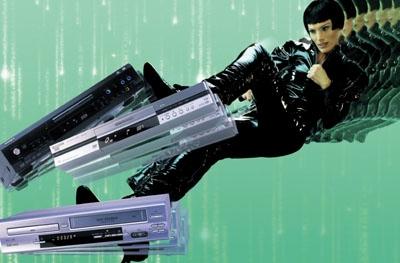DVD Dimensions

Opening photo, remotes, and back panels by JaymeThornton.com
You're comfortable in your armchair. Your feet are warm in fuzzy slippers. The remote control rests easily in your hand, and your fingers absently explore that rough edge where the dog chewed it. Ahh, the reassurances of reality, the things we take for granted. For example, that all DVD players are basically alike. Except for small differences in features, they all perform the same essential functions.But all DVD players are not alike. With players now in more than 40% of American homes, the options abound - from DVD/VCR combos to DVD recorders to models whose playback capabilities extend to formats like DVD-Audio and Super Audio CD. In short, DVD player design is expanding into a pleasing diversity - one for any particular reality you happen to inhabit. To help survey the increasingly complex matrix of DVD, let's zero in on three distinctive models: Hitachi's DV-PF73U DVD player/VCR combo ($180), Panasonic's DMR-E50 DVD player/recorder ($500), and Integra's DPS-8.3 "universal" SACD/ DVD-Audio/Video player ($1,200).
The First Dimension
The Hitachi DV-PF73U represents both the best of times and the worst of times. The VCR was once the mightiest of electronics products. As recently as 2000, the videocassette recorder's peak year, Americans bought 35 million VCRs. But DVD quickly overcame VHS despite videotape's recording advantages. DVD picture quality is dramatically better, surround sound became the rage, and rewinding was eagerly forgotten. Yet legions of VHS tapes are still in collections, archiving everything from feature films to family vacations. 
|
The DVD side is understandably more modern. The Hitachi can provide a progressive-scan output through its component-video jacks and can play CD-R/RW discs (including those with MP3 files) as well as DVD-R discs. Its disc navigator displays a thumbnail of the first scene of each chapter in a title - the current one is even animated. There are all the usual transport features, including random and programmed playback for CD-R/RW discs with MP3 files. A screen saver and automatic power-off round out the features.
 The black-faced remote control is rather formidable looking, particularly for a $180 player. This is partly because it operates two disparate devices, but it also offers a comprehensive set of controls.
The black-faced remote control is rather formidable looking, particularly for a $180 player. This is partly because it operates two disparate devices, but it also offers a comprehensive set of controls.
Setting up the DV-PF73U did not require solving any metaphysical paradoxes - the player's setup menus are so straightforward that even a child could run through its limited options. The rear panel has an RF input to connect an antenna or cable box to the VCR side and a handful of other standard A/V inputs and outputs (see back-panel photo below and "Features Checklist" PDF). 
I connected the antenna input to my cable tap and both the coaxial digital and analog audio outputs to my receiver, the first for DVD playback and the second for VCR playback. I connected the component-video output to my TV for DVDs - of course, this connection provides the best picture quality - but for the VCR I had to use the composite-video connection in the A/V output shared by the two sides.
A front-panel button lets you choose either DVD or VCR playback - you can't have both at once, though you can play a DVD while making a recording. So I started my evaluation of the DV-PF73U with tape playback. Like most folks, I have a box of old VHS tapes I use mainly to gather dust. Picture and sound quality were certainly not in the DVD league but more than satisfactory for VHS.
Although you can't tape most DVDs because they're copy-protected, the Hitachi deck does a few tricks that my old VCR couldn't. Each time I started a recording, it set an index mark, and during subsequent playback, I could set the number of index marks I wanted to skip over. Alternatively, I could enter the length of time I wished to skip over. During recording, I could set a stop time in 30-minute increments.
To evaluate the DVD performance of the three players in this roundup, I turned to the quintessential parallel-universe parable, The Matrix - the original movie and still a visual and sonic feast. The first fight scene sets the tone for all the rest. The Hitachi player's component-video output made virtual reality seem pretty damn authentic on my widescreen Princeton HDTV monitor. When the policemen shine their flashlights through dusty air, I saw smooth gradations of gray across the beams of light. When Trinity is cornered in a dimly lit room, the muted colors looked properly dark, and her slo-mo, mid-air fighting moves looked properly three-dimensional as the camera swings around her body. In short, picture quality was surprisingly good.
Although the DV-PF73U's role in audio reproduction is limited, its coaxial digital output conveyed all the nuances of the soundtrack to my receiver without any glitches.
- Log in or register to post comments






























































